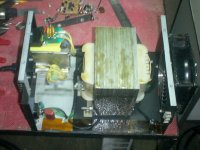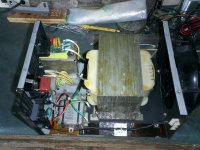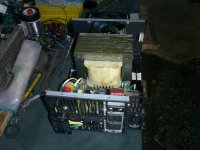Three good papers, it's well worth your time reading the pertinent sections.
"Power White Paper" from Middle Atlantic.com
Middle Atlantic Products - White Paper - Integrating Electronic Equipment and Power into Rack Enclosures
The Bill Whitlock of Jensen Transformers Seminar paper
http://centralindianaaes.files.wordpress.com/2012/09/indy-aes-2012-seminar-w-notes-v1-0.pdf
The Jim Brown of Audio Systems Group white paper
"Power and Grounding for Audio and Audio/Video Systems"
http://www.audiosystemsgroup.com/SurgeXPowerGround.pdf
"Power White Paper" from Middle Atlantic.com
Middle Atlantic Products - White Paper - Integrating Electronic Equipment and Power into Rack Enclosures
The Bill Whitlock of Jensen Transformers Seminar paper
http://centralindianaaes.files.wordpress.com/2012/09/indy-aes-2012-seminar-w-notes-v1-0.pdf
The Jim Brown of Audio Systems Group white paper
"Power and Grounding for Audio and Audio/Video Systems"
http://www.audiosystemsgroup.com/SurgeXPowerGround.pdf
Strange enough I got this message in my mail, from DIY Audio, but the message never appeared in the thread.
--------------------
From: Jean-Paul
Hi, does anyone realize what will happen if a fuse blows on the secondary side ?
I think this is an unsafe solution.
--------------------
I have heard that a few times before, and I am very uncomfortable building the thing, before it is clear to me if it safe enough like I have drawn it in Pic 1. People seem to agree on that the best possible noise damping is between 6 - 10 dB. I think on common noise.
Briefly reading through the suggested 3 documents shows that people generally are not very impressed with balanced mains. But what else to do with this heavy boat achor ? I have no boat
If somebody dont feel like reading 500 pages, symmetric mains are on p22 in the SurgeX doc, on p 36 in the power paper, and on p 201 in the doc "Everything you thought you knew ... but you didnt" A very good paper indeed, but it moves some borders.
A very good paper indeed, but it moves some borders.
--------------------
From: Jean-Paul
Hi, does anyone realize what will happen if a fuse blows on the secondary side ?
I think this is an unsafe solution.
--------------------
I have heard that a few times before, and I am very uncomfortable building the thing, before it is clear to me if it safe enough like I have drawn it in Pic 1. People seem to agree on that the best possible noise damping is between 6 - 10 dB. I think on common noise.
Briefly reading through the suggested 3 documents shows that people generally are not very impressed with balanced mains. But what else to do with this heavy boat achor ? I have no boat
If somebody dont feel like reading 500 pages, symmetric mains are on p22 in the SurgeX doc, on p 36 in the power paper, and on p 201 in the doc "Everything you thought you knew ... but you didnt"
I dont have notable noise in my system, just wanted to do everything to make i good/better.
... darker background, better soundstage - you know all the voodoo
Still not sure what to do: Balanced, unbalanced, just RF filters ...
And then what to do with this expensive trafo.
... darker background, better soundstage - you know all the voodoo
Still not sure what to do: Balanced, unbalanced, just RF filters ...
And then what to do with this expensive trafo.
Thats exactly what people dont like about the concept. If the fuse in a connected device blows, you still have half mains supply on the unit - with no fuse protection.
In most of the Europe there is no live and neutral distinction on the mains plugs, so, even without balanced power transformer, we live with that anyway. There is RCD switch for the rescue
The primary fuse should be close rated. That demands that the isolating transformer has a soft start circuit and for best efficiency and lowest source impedance, that soft start current limiting device should be bypassed.
Since the isolating transformer will never be working at maximum output for a continuous period, it will work well if the primary fuse is slightly undersized.
That close rated fuse will blow if the isolating transformer suffers a considerable overload for longer than a few seconds.
That is your MAINs protection.
You can add on a leakage current detector for additional protection.
BUT this is ONLY an ADDITIONAL protection. It is NEVER in lieu of the overload fuse.
Since the isolating transformer will never be working at maximum output for a continuous period, it will work well if the primary fuse is slightly undersized.
That close rated fuse will blow if the isolating transformer suffers a considerable overload for longer than a few seconds.
That is your MAINs protection.
You can add on a leakage current detector for additional protection.
BUT this is ONLY an ADDITIONAL protection. It is NEVER in lieu of the overload fuse.
Last edited:
There have been a few things in this thread that I find really scary.
The notion of running a separate and not cross bonded earth for the hifi is just really, really dangerous, as it amounts to bringing an external potential into the equipotential zone which is a total nono with most PME installations. If you must go here cross bond to the mains earth terminal with wire sized to meet the regs.
The hospital use case is generally actually an IT (Earth free) system setup with an earth fault monitor which sounds an alarm if any path to earth comes into existance. This is done so that a single earth fault will not compromise the power to an operating room, better to have an alarm go off and get it fixed after the surgery is over then have all the power trip out.
230V balanced power can be done safely, but it is a bit of a mission, requiring double pole breakers (and RCDs) for each secondary circuit, and requiring a very reliable earth bond to the centre tap. In general such things have to de designed as a system, including the protection, distribution and load fusing, this is electrical engineering not electronics or domestic electrics.
I would be inclined to consider this as in the same category as discussion of non isolated switchmode design, not a proper topic for this forum.
It is also generally not a particularly effective cure for anything! Current in any power network is inherently balanced (so there can be no reduction in magnetically induced power frequency coupling, because that does not change), and low frequency electric fields are about the worlds easiest things to screen.
Now if I had such a transformer taking up space, I might either configure it as an isolating transformer with floating output for use with a SINGLE load (This is not something that can safely be used to power multiple loads due to issues with the lack of double fault to chassis protection), or possibly as a separately derived supply, with one side of the secondary bonded to ground, which can power multiple loads and removes DC and common mode noise, at the cost of raising Zs compared to the raw grid and possibly making it take longer to clear faults.
Please this stuff falls solidly into the 'if you have to ask' category, be careful out there and consider all the failure modes of both your box and the connected loads.
Regards, Dan.
The notion of running a separate and not cross bonded earth for the hifi is just really, really dangerous, as it amounts to bringing an external potential into the equipotential zone which is a total nono with most PME installations. If you must go here cross bond to the mains earth terminal with wire sized to meet the regs.
The hospital use case is generally actually an IT (Earth free) system setup with an earth fault monitor which sounds an alarm if any path to earth comes into existance. This is done so that a single earth fault will not compromise the power to an operating room, better to have an alarm go off and get it fixed after the surgery is over then have all the power trip out.
230V balanced power can be done safely, but it is a bit of a mission, requiring double pole breakers (and RCDs) for each secondary circuit, and requiring a very reliable earth bond to the centre tap. In general such things have to de designed as a system, including the protection, distribution and load fusing, this is electrical engineering not electronics or domestic electrics.
I would be inclined to consider this as in the same category as discussion of non isolated switchmode design, not a proper topic for this forum.
It is also generally not a particularly effective cure for anything! Current in any power network is inherently balanced (so there can be no reduction in magnetically induced power frequency coupling, because that does not change), and low frequency electric fields are about the worlds easiest things to screen.
Now if I had such a transformer taking up space, I might either configure it as an isolating transformer with floating output for use with a SINGLE load (This is not something that can safely be used to power multiple loads due to issues with the lack of double fault to chassis protection), or possibly as a separately derived supply, with one side of the secondary bonded to ground, which can power multiple loads and removes DC and common mode noise, at the cost of raising Zs compared to the raw grid and possibly making it take longer to clear faults.
Please this stuff falls solidly into the 'if you have to ask' category, be careful out there and consider all the failure modes of both your box and the connected loads.
Regards, Dan.
Very pertinent point of safety............... breakers (and RCDs) for each secondary circuit, and requiring a very reliable earth bond to the centre tap............
A mains RCD cannot protect the secondary after the isolating transformer.
The RCD must be in the secondary circuit to give the high voltage protection against HV secondary faults in the isolating transformer.
- Status
- This old topic is closed. If you want to reopen this topic, contact a moderator using the "Report Post" button.
- Home
- Amplifiers
- Power Supplies
- Balanced 230v mains supply - oppinions please!


